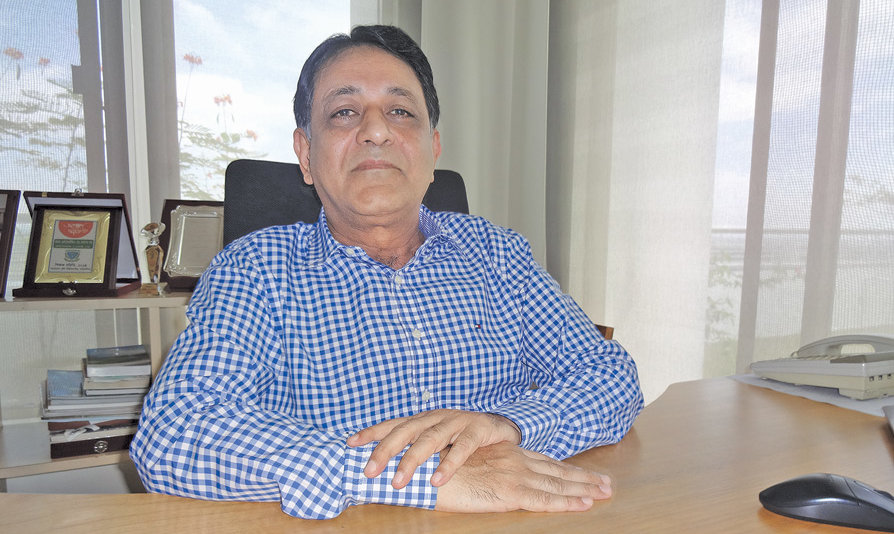The knitting industry, whether flat knit or circular knit, is driven by integrated capacities from knitting to garmenting. Bangladesh has taken leadership position in this segment for long and established a reputation of being upfront in staying at the position, investing in technology to continue as frontrunners in this segment. At ITMA, many Bangladeshi companies were seen at the various booths seriously exploring the new technologies and also understanding how the same would be able to add value to their business. It is notable that most of the technology providers too were excited to interact with the teams and as one technology provider said, “Today, the commitment to invest in automated and superior technology is coming from the South-east Asian countries, and Bangladesh in particular.” Through our lead story, the spirit of investment in the country and the new technology as shown at the ITMA are under the spotlight…
Knitwear sector going for major automation
Sweater manufacturers installing 2nd and 3rd batch of automatic flat knitting machines; Shima Seiki & STOLL emerge frontrunners

The role of knitwear sector in Bangladesh’s growth and development as a global leader in the apparel sector is immense! Registering momentous growth in last couple of decades – the category not only contributed significantly towards employment generation, women empowerment and poverty alleviation – it also played an important role in enhancing the country’s GDP. In the process, the segment has pushed woven into second position in domestic value addition, which for the knitwear sector stands at an overwhelming 75 per cent, contributing 10 per cent to the country’s GDP in terms of value addition.
Today, the knitwear sector, which can broadly be divided into two categories – circular knit (having fabric gauge of 12 to 22 and used for manufacturing T-shirts, lingerie, etc.); and flat knit (gauge ranging between 2 to 10 and used for manufacturing sweaters) – have in tandem been making steady progress in the country. Keeping pace with the growth, entrepreneurs have also strengthened backward linkages. Besides increasing their stitching capacities significantly, knitwear manufacturers have invested in allied industries to augment the overall capacity of the sector so much so that Bangladesh now scores over its competitors both in terms of pricing as well as product quality; thanks to industrial agglomeration, vertical integration and technological innovations.
While in circular knits the development has been more in terms of increased capacities, the flat knit has witnessed major developments in terms of technology. Aiding the growth of flat knit is the shift of not only the jacquard business from China to Bangladesh but the sweater business as a whole, due to rising labour costs and scarcity of skilled operators for linking operations in China. The trend has also encouraged many new companies to enter sweater manufacturing in the hope of replicating the growth revolutions of the late 90s. The advent of automatic flat knitting machines have further added an impetus with host of manufacturers engaged in the process of installing their 2nd or 3rd batch of automatic flat knitting machines.

“The kind of capabilities the country has for sweater manufacturing is difficult to be replicated by any other country, as not only is the investment huge but also the expertise and support system required have not kept pace with time in other countries,” opines Saiful Hoque, Chairman of Sky Apparels, a comparatively new entrant in the sweater industry, who has installed first set of 100 flat knitting machines from STOLL in December 2013. Another set of 100 automatic flat knitting machines are ready to join the automatics from STOLL shortly.
Another sweater giant, Sonia & Sweaters has already installed 100 Shima Seiki machines and is committed to having 1,000 such machines in a phased manner over the next five years. “Profits are shrinking, labour is becoming expensive and buyers are looking for innovation. The only way to tackle these challenges collectively is to invest in automation,” reasons Enayetuddin Md. Kaiser Khan, MD, Sonia & Sweaters Limited. He also adds that sweaters are becoming an important category in Bangladesh as now buyers get not only basic hand flats, but intarsia and other high-end knit options too. Having created a niche in 12 and 14 gauge sweaters, Sonia & Sweaters caters to brands like Marks & Spencer, Kenneth Cole, Gap, Metro Group, Carrefour Group, George and Betty Barclay Group.

Following the automation trend, US $ 60 million Crown Fashion & Sweater has installed 126 automatic flat knitting machines from STOLL and is looking to follow it up with more. “Since the programming system of the machines from both the brands (STOLL and Shima Seiki) are completely different, I wouldn’t like to change the brand as we have a huge team of sampling operators and knitting machine programmers who are already trained on STOLL machines,” shares Rezaul Ahsan, Chairman of Crown Fashion & Sweater, who also has two yarn dyeing facilities with a capacity of nearly 25 tonnes per day which cater to 75 per cent of the sweater manufacturers in the country. Manufacturing sweaters in gauges ranging from 3 to 12, the company majorly caters to the European market and is working with brands like H. Obermayer Gmbh, Karstadt Warenhaus AG, Distra Warenhandels, Gruppo Coin (OVS), Primark, Okaidi and Vegotex International.

A France-Bangladesh joint venture company L’Usine Fashion added 186 automatic flat knitting machines from Honkima and Juinn Long, replacing its 560 hand flat knitting machines in 2014, which along with Sky Apparels is now set to invest for heavy knit sweaters following the heavy gauge trend. Incidentally, STOLL recently introduced a heavy gauge knitting machine at ITMA which gives the look of a hand-knitted sweater in anticipation of the growing trend. “Basic products are necessary for sustenance, as they offer lower margins but bigger quantities; while the small order design-oriented products are for making profits. I don’t know about others but this is my way of operating and with the new machines coming in from STOLL (for heavy gauges) and Cixing (for finer gauges) in our two upcoming factories, my share of jacquard and intarsia sweaters will increase and with it the FOB of my products,” shares Prabir Saha, Managing Director of L’Usine Fashion.
Many companies are looking at major growth having invested in automation in the last few years. Investment in 100 automatic knitting machines from STOLL is now a two years old investment for the Crony Group and gives confidence that the turnover will touch the mark of US $ 120 million in 2016. Mauritius-based Floreal Knitwear Group, which produces 5.5 million sweaters per year, plans a big expansion in Bangladesh where it already produces 1.5 million pieces. “Our strategy is to double our production volume in Bangladesh within two years and produce 30,00,000 pieces there,” informed Jean-Baptiste de Spéville, Chief Executive Officer of Floreal. The group has injected Mauritian Rupee 50 million (US $ 1.65 million) in the expansion project. Floreal specializes in manufacturing sweaters of cashmere, lambswool and merino.
Driving the trend of automation in Bangladesh, which started around year 2010, are companies like Shima Seiki and STOLL as manufacturers in overwhelming numbers and which opted to build capacities to produce high-end jacquard and intarsia sweaters, a speciality of these two machines. The reason for such major investments in the jacquard market was the expected flow of business to Bangladesh from China. However, despite the popularity of Shima Seiki and STOLL, companies from China like Cixing, Juinn Long, Gosheng and Honkima have not failed to capture substantial market shares; thanks to their single system machines, which apart from being cost-effective also serve as a replacement for the hand flat knitting machines and the first contact point to automation before graduating to high-end machines.

The popularity of automatic machines has led to sweater manufacturers to experiment by mixing the automatic variants. Both Sky Apparels and L’Usine Fashions have installed automatic machines from Shima Seiki, STOLL and Cixing to gain excellence and improve productivity. “It creates competition on the shop floor and as a sweater manufacturer we get the best service and response from all the companies. Moreover the operators can be easily trained to handle machines from different brands as the only difference while operating is in the software programming,” says Saiful.
Alamgir Kabir, Managing Director, Best Wool Sweaters, one of the biggest sweater manufacturers of Bangladesh with 1,600 hand flats, 500 Shima Seiki and 400 Chinese semi-automatic flat knitting machines says, “There is no comparison of hand flat and automatic flat knitting machines on speed and both machines are designed to serve different purposes.” Manufacturing sweaters ranging from 3 to 14 gauge, Best Wool Sweaters is majorly catering to the European market.
Knitting @ ITMA presents Advance Technology…
Functionality, Fashion and New Applications the Directions
Among the key segments that saw major developments and even a few breakthrough technologies at the recently concluded ITMA was ‘knitting’. The wide range of knitting solutions – from flat knits to warp knitting to circular knits to seamless technology – all were on display for the many visitors who thronged the corridors over the week-long event. Asian companies, mostly from the Indian sub-continent, were seen in large numbers and it was not surprising that for many technology manufacturers, this region is a focus market, with both strategy and machines being made to penetrate the potential this region presents today.

Each segment in knitting had some new machines to show, but the biggest ‘disruptive’ innovation was in circular knitting with two companies putting forward their version of a knitting machine wherein the spinning aspect was integrated. While Pailung from Taiwan previewed to some select customers a circular knitting machine that directly uses sliver instead of yarn for knitting fabric, Mayer & Cie presented its ‘spinitsystems’ that is a 3-in-1 concept where spinning, cleaning and knitting happens on one machine. On the new machine, knitwear is manufactured not from yarn, but straight from the fibre roving, significantly shortening the production process and also reducing the capital expenditure required for a knitting unit.
Though Pailung was still keeping the technology under wraps, Mayer & Cie confidently talked about the advantages and also applications of the technology. The brand also claims that the versatility of the machine is such that besides natural fibres like cotton, the machine can also knit synthetic fibres from the short staple area, such as viscose, modal or polyester. Not forgetting the sustainable importance of technology, the ‘spinitsystems’ claims 30 per cent lower CO2 emissions running at 25 RPM to produce 20 kg/hour of knitted fabric.
Another interesting development in circular knits came from the Korean company Keumyong, which after two years of dedicated R&D in association with Nike, has introduced a double knit electronic full jacquard with rib-mesh machine (KCMJD-169S). This new technology allows circular knits to enter new product markets like shoe fabrics. The electronic individual needle selection and unlimited patterning variety realize the quality of jacquard and versatility of fabrics. “Though both flat knitting and warp knitting are presenting options for the shoe industry, circular knitting is much faster and changing colour here is so much simpler. We already have an order for 1 million pair of shoes from Nike on this machine and any company which invests in the technology does not need approvals for the same,” claims C.W. Son, Office Manager (Seoul), Keumyong Machinery.
Displaying its version of the double knit double selection electronic jacquard knitting machine, under the Knitel series, Pailung was promoting the machine for home textile applications, more so for knitted mattress, which is a growing trend today. “The Pailung brand has been doing exceedingly well in India and Bangladesh as it is a good balance of high-end reliable technology and price. R&D is the core growth engine of the company and the industry players are offered new options to expand their business on a regular basis,” said M. M. Elango, CMD, Yuvraj Merch-X, agents for Pailung in India. Also joining the Pailung range of knitting machines are a high speed range of circular options from Vanguard, USA. Focused at increased productivity, VPL (Vanguard Pai Lung) is not looking at only increasing speed, but also tackling all issues that arise out of increasing speed. “Our machine knits about 2,000 pounds a day at 60 RPM, with controlled vibration and heat. We don’t have many machines and we knit only jerseys and fleece, but we dominate our region on speed. Machines can be customized from a select range of frames, diameters and gauges,” informed Mike Moody, VP, Product Development, VPL.
Warp knitting is another area that is developing fast and companies like Karl Mayer have taken development to the stage where one will not have to wait for too long to see warp knitted fabric replacing weaving in manmade fabrics. Produced much faster, sturdier and endowed with stretch, the fabric produced are now being extensively used in lingerie and sportswear, and as automotive textiles and shoes fabrics. The HKS series on display at the fair attracted many visitors. Representing Karl Mayer in India, A.T.E. Enterprises was very happy with the response. “Weaving has always been a very capital-intensive industry and now high-end elastic fabric with performance value can be made anywhere, putting an end to limitation in fabric suitable to performance-driven segments like sportswear and shoes,” said Vikram Chaurasia, Deputy GM, Textile Engineering – Fabric Forming, A.T.E.
While warp knitting was focusing on performance, the two big companies in flat knitting were concentrating on fashion as the USP. Shima Seiki had put on display a complete new collection of fabrics/products created from their machines, along with three upgraded versions of the WHOLEGARMENT concept which is celebrating 20 years of innovation. The designs were highly complicated and the final products were being lapped up by many European customers. “The technology we are displaying here is more suitable to the European customers who are looking for new inspirations in designs,” said Ikuto Umeda, Executive Director, Shima Seiki Mfg. Ltd. For the company, while Europe is the high-end market, the big mass market is in Asia, particularly India and Bangladesh.
There is no doubt that Bangladesh is the second largest market for flat knitting machines today after China, and the companies are going all out to capture the growth. “In last three years we have sold 5,000 machines to Bangladesh, and though the market is a bit shaky now because of huge investment in automation without prior preparation of trained manpower, the market should continue to grow, albeit a bit slower, over the next two years before picking up speed again,” predicts Thomas Hoffmann, Area Sales Manager, STOLL who is looking after the Bangladesh region. Hoffmann further shares that there are three major factors that are responsible for the growing demand for automation in Bangladesh, the first being the increasing wages in the country, the second being the need to give more consistent quality, and finally for the simple reason that it is easier to be a compliant factory with less workers!
Contrary to common perception, automated machines from branded companies are not direct replacements for hand-flat machines, being commonly used in Bangladesh. “Hand-flats are being replaced by Chinese machines which are semi-automated and give better productivity, but still translate into one machine per person. Our machine replaces around 7 hand-flats and one person is operating 4 machines on an average; this means that one machine replaces about 23 people,” argues Hoffmann. He adds that in China the ratio is 8 machines per person and in Turkey it is as high as 12 machines per operator. Of course productivity per person is not only about skill levels of the operator but also the quality and type of yarn being used. The company had on display a new coarse knitting machine (STOLL CMS series) with the ability to give authentic hand knitted look.
“Knit one, purl one” on a STOLL CMS 520 C+ multi-gauge machine

Keeping pace with fashion trends, STOLL has expanded its gauge range further, adding gauge E1.5 and gauge E2.2 for the extra-bulky knits and extra-chunky yarns that previously demanded hand knitting. Gauge scalability now extends stitch optics from gauge E1.5 to gauge E5; yarns down to 0.7 nm can be used. Moreover, the industrial knitting machine offers countless design options: jacquard, intarsia and structured knits – combined with shaping at tributes in Fully Fashion technique. The design applications extended beyond apparel and included accessories and interior design.
Earlier this year STOLL announced a limited partnership with Shanghai-based Shang Gong Group (SGG) which is focusing on sewing and textile welding. Management at STOLL emphasizes that all current corporate values – i.e. innovation, quality, service, support and responsiveness – will remain key priorities. This partnership supports future growth and sustainability and is the basis for further expansion of products and solutions. STOLL will benefit from additional know-how and an even broader presence in Asia. “SGG is a strong international partner which deeply understands the textile industry. With its famous German brands Dürkopp Adler, PFAFF Industrial and KSL Keilmann, SGG also has a significant footprint with considerable operations in Europe. In addition, SGG can facilitate deeper access to the Chinese and Asian markets,” says Thomas Hoffmann, Area Sales Manager, STOLL.
In the last three years we have sold 5,000 machines to Bangladesh; and even though the market is a bit shaky now because of huge investment in automation (without prior preparation of trained manpower), the market should continue to grow, albeit a bit slower… Our machine replaces around 7 hand-flats and one person is operating at an average 4 machines this means that one machine replaces about 23 people.
Shima Seiki concentrating on WHOLEGARMENT

The exhibition was a showcase for the company’s latest selection of computerized flat knitting machines, which gathered great interest from visitors. The new flagship MACH2XS WHOLEGARMENT knitting machine with SlideNeedles mounted on four needle beds and spring-type sinkers, the compact SWG-N2 series WHOLEGARMENT knitting machine with capability for industrial textiles, as well as the SRY183LP with loop pressers that produce unique knitwear with woven textures, is now available in ultrafine 16 gauge. MACH2X achieves a maximum knitting speed of 1.6 metres per second. The R2CARRIAGE system furthermore permits quicker carriage returns for higher efficiency per knitted course. Split Stitch technique also allows efficient knitting by eliminating empty courses. Additionally, MACH2X123/153 features 18L gauge capability whereby a special large-hook version of the SlideNeedle is used for knitting 15-gauge fabrics at 18-gauge needle pitch for very high productivity when knitting ultrafine gauge garments. The tighter needle pitch also allows for a tighter fabric especially for ribs, contributing to higher-quality WHOLEGARMENT items. Additional improvements include a control unit that is built-in to the machine for simplified shipping and installation, easier maintenance, and more efficient use of space. A USB memory interface and a backup power supply are standard. MACH2X also features a lower overall height for improved access to top tension units.
The technology we are displaying here is more suitable to the European customer who is looking for new inspirations in designs. We have displayed a complete new collection of fabrics/products created from their machines, along with three upgraded versions of the WHOLEGARMENT concept, which is celebrating 20 years of innovation…
Keumyong introduces a circular knitting machine for shoe manufacturing

The Keumyong booth at ITMA was a beehive of activities as the Korean circular knitting machine manufacturer had developed a jacquard model, made specifically for the production of footwear – KCMJD-169S. The double knit electronic full jacquard with rib-mesh machine is a multipurpose double knit machine with a wide range of stitch options that comes in two diameters of 30 inches and 34 inches with gauge options from 12-18. The machine runs at an RPM of 12-15 and has a 3 position needle selection by WAC (Knit, Tuck and Welt). The company is very upbeat of the immense potential of the machine and feels that it will change the way sports shoes are being made today.
Pailung thrives on wide range of knitting machines

The Taiwanese manufacturer of knitting machines is one of the most popular in Asia, with good market share in both India and Bangladesh. The company has machines for all applications from basic fabrics to specialized fabrics for use in home furnishing, sportswear, automotive industry, healthcare and industrial purposes, under three categories of machines – Knitel, Weevknit and Rediknit. The knitting machines are custom built for brands, designers, textile manufacturers, and contractors in the fashion, home, healthcare, and environmental textile industries.
The company believes in the collaborative approach to R&D and works closely with customers to build better knitting machines for current industry needs. They also claim to be fast on the delivery of customised machines, allowing clients to keep pace with most challenging needs and aspirations. At ITMA, among the many machines on display, the mattress knitting machine was drawing good attention from visitors. PL-KDDSCJ is a thoroughbred model with the latest technology and refinement, which can present very clear patterns of multiple colour designs on the front face without colour moving to the backside.







